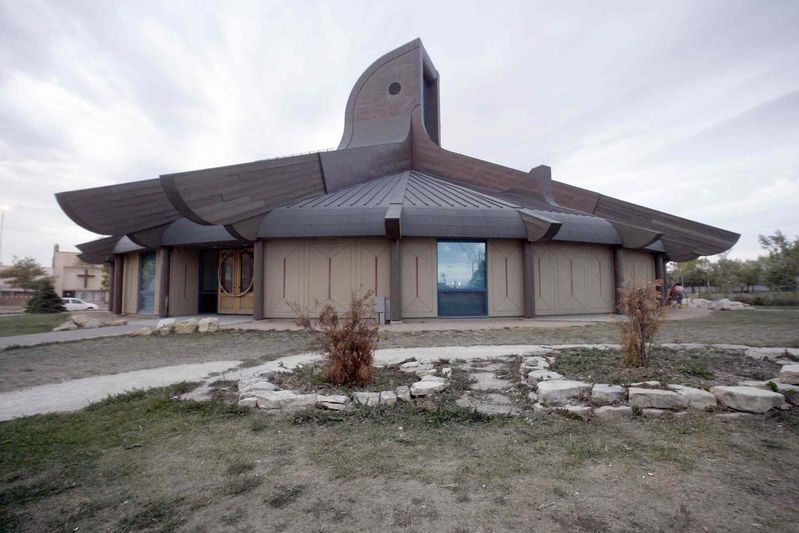By Brent Bellamy, Creative Director and Architect


Thunderbird House on Main Street is designed by architect Douglas Cardinal, who infuses modern architecture with indigenous beliefs and traditions.
- PHOTO BY MIKE APORIUS/WINNIPEG FREE PRESS FILES
The Maclean's article -- three words that when spoken anywhere in Winnipeg over the past few weeks would invariably spark a passionate and polarizing conversation. It is not often that a national periodical publishes such a charged condemnation of an entire city, but shining a spotlight on Winnipeg's racial divide has created an opportunity to further an already pervasive dialogue about our city's most complex challenge.
More indigenous people live in Winnipeg than in any other Canadian metropolitan area, representing the city's youngest and fastest-growing community. As a proportion, Métis and First Nations people have gone from constituting 2.9 per cent of the city's overall population in 1981 to more than 13 per cent today.
As such, the prosperity of the indigenous community has become indivisible from that of Winnipeg's success as a whole.
Much of the discussion following the Maclean's article has addressed the need to weave together Winnipeg's torn communal fabric. In order to realize long-term prosperity within the indigenous community, enabling greater social and cultural inclusion is imperative. The opportunity exists for Winnipeg to become a leader in this pursuit by exploring new ways of injecting our city's architecture and urban design with indigenous values that allow aboriginal people to see themselves in the spaces and places we inhabit.
Incorporating indigenous cultural narratives within our urban and architectural design might help begin to heal our social divide and encourage aboriginal people to reconnect with their own culture and stimulate a more personal relationship with the city that is their home.
The interpretation of indigenous culture in modern architecture has always presented a challenge in North America. As historically nomadic people, there is little tradition of permanent-built structures to draw inspiration from. As a result, designers have looked to reinterpret other art forms and cultural symbolism at an architectural scale. This strategy has often led to buildings with an aboriginal theme of colours, shapes and images layered on to the design.
Calgary's Douglas Cardinal became the first major architect to move beyond representation through traditional iconography and explore the ideas of infusing modern architecture with the underlying principles of indigenous belief and tradition. An architect of Métis and Blackfoot heritage, he has designed buildings such as the Museum of Civilization in Ottawa, First Nations University in Regina and Thunderbird House on Winnipeg's Main Street. He believes architecture must flow out of the land, allowing the landscape and the sky to weave seamlessly throughout its spaces. His often organic, sculptural forms react with light, shadow, wind and rain to change their mood throughout the day and the seasons. He uses the texture and warmth of natural materials, such as copper, stone and wood to create a human-scale connection with his buildings that often appear to embody the indigenous ideal of treading lightly on the land.
Following its Visionary (Re)Generation International Design Competition for the development of a new community on the Southwood Golf Course, the University of Manitoba has challenged itself with becoming a global leader in the exploration of urban and architectural design principles that are inclusive to indigenous cultures. The university's research and real-world implementation of its work may become a model for development in the rest of Winnipeg and other cities looking to heal cultural divides and empower their indigenous population.
The university has begun creating a framework of principles and methodology that will inform and guide the development through design and construction over the next 20 years. The process begins by reinforcing the vital importance of listening. An elders council has been established to inform and guide decision-making with the goal of creating a collaborative partnership that enriches the design with cross-cultural ideas shared through traditional storytelling methods and ongoing dialogue.
Building on the work of Cardinal, the U of M hopes to create a unified community by establishing a sense of belonging for indigenous people that is also a welcoming and inclusive place for those of all cultures. To achieve this, designs will incorporate indigenous cultural principles in ways that will build a sense of harmony and well-being for all. The design will celebrate connections to the surrounding landscape and rivers. Parks will engage people with active green space used for growing and harvesting foods and medicines in traditional ways. Natural wildlife habitat and drainage patterns will be considered, and buildings will be oriented to maximize access to the sun and shelter from the winds.
Indigenous lifestyle and tradition will be supported through the development of public and private spaces that are designed for cultural celebration and ritual as well as multigenerational interaction that will be reinforced by extended-family housing and daycare options.
Overall development will be guided by the Seventh Generation Principle, an ancient indigenous philosophy that teaches to think beyond the immediate needs of today and consider the impact our decisions have on past, present and future generations. The message reinforces the fundamental value of sustainable development and environmental stewardship, restoring balance between the economy, the environment and human well-being.
The work being done by the U of M shows with strong leadership and dedication to finding creative solutions, we might be able to develop a process for urban and architectural design that empowers our indigenous population and begins to heal the racial fracture in our city.
By striving to build a city that is a cultural reflection of our modern society, we have an opportunity to turn Winnipeg's greatest challenge into its most valuable asset. The solution can be an expression that is unique to Winnipeg, a modern, forward-looking, sustainable city built on the ancient foundations of indigenous tradition passed to us through centuries of living on this land and in this place.
With indigenous voices in roles of influence helping to guide and enrich our urban landscape, we can create a culturally inclusive city, defined by architecture and public space not superficially layered with aboriginal iconography but imbued with the DNA of indigenous cultural ideals. A city defined by buildings that are constructed with permanence and natural materials, created as celebrations of sunlight, landscape and climate that are tied to the rhythms of nature, will inspire wonder in the human spirit, creating a strong sense of place and an undercurrent of inclusiveness that engages all of Winnipeg's citizens.
Brent Bellamy is senior design architect for Number Ten Architectural Group.
Republished from the Winnipeg Free Press print edition February 9, 2015 B4

